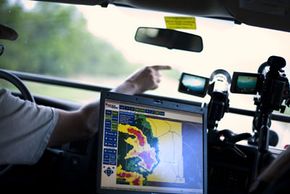Advanced Storm Chaser Gear
Meteorologists have constructed special vehicles loaded with weather detection equipment and have even designed devices intended to be sucked into a tornado, where they could gather information.
The Totable Tornado Observatory (TOTO) was one of the first tornado observation devices, built by the National Severe Storms Laboratory in 1981. It was basically an oil drum packed with scientific instruments. It could be left in the path of an oncoming tornado, where it would collect information about conditions as the tornado passed over, or even from within the tornado itself. TOTO never actually got into a tornado, unfortunately.
Advertisement
Other attempts to gather data from the inside of a tornado include smaller versions of TOTO, such as Dillo-cam. One experiment involved firing rockets into a tornado from an airplane!
Doppler On Wheels (DOW) is a vital component for advanced storm chasers. It's the same technology used to create the radar weather maps you see on your local news, but mounted to the back of a truck. This gives the chasers immediate, on-the-spot info about weather conditions. In 1999, a DOW truck recorded the world record tornado wind speed, 318 mph, in Oklahoma [source: World Book].
A few storm chaser crews deploy their own radiosondes. These are weather balloons. When released, they rise through the atmosphere, recording air pressure, wind speed and direction, and temperature data.
The most amazing storm chaser gear comes in the form of chaser vehicles. These range from simple modifications like additional batteries to power all the computers and radios, to the outlandish TIV2, which looks like something that drove straight out of "The Road Warrior."
TIV stands for Tornado Intercept Vehicle. The first TIV was a heavily modified pickup truck. You can learn all about it in How the Tornado Intercept Vehicle Works. TIV2 is an even more radical design. The truck is heavily reinforced and weighs roughly eight tons [source: Discovery Storm Chasers blog]. The weight makes it harder (but not impossible) for a tornado to lift. It has hydraulic jacks that extend body panels down to the ground, preventing tornadic winds from getting underneath the truck. The truck can also extend stabilizing jacks down to the ground. Lots of electronic gear, including weather and communications equipment, is wired directly into the dashboard. The windows are designed to give camera operators the best possible view of an incoming storm.
Up next, we'll try to figure out why people do this sort of thing.
